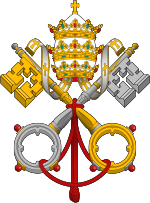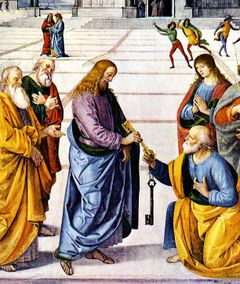Pope Zephyrinus
| St. Zephyrinus | |
|---|---|
 |
|
| Papacy began | 199 |
| Papacy ended | December 20, 217 |
| Predecessor | Victor I |
| Successor | Callixtus I |
| Personal details | |
| Birth name | Zephyrinus |
| Born | ??? Rome, Roman Empire |
| Died | December 20, 217 Rome, Roman Empire |
| Sainthood | |
| Feast day | December 20 |
| Papal styles of Pope Zephyrinus |
|
|---|---|
 |
|
| Reference style | His Holiness |
| Spoken style | Your Holiness |
| Religious style | Holy Father |
| Posthumous style | Saint |
Pope Saint Zephyrinus, born in Rome, was bishop of Rome from 199 to 217. His predecessor was bishop Victor I. Upon his death on December 20, 217, he was succeeded by his principal advisor, bishop Callixtus I.
Contents |
Papacy
Despite his long pontificate relatively little is known of him. His critic, Saint Hippolytus, described him as a simple man without education, a weak man "unskilled in the church's rule" and dominated by his deacon Callixtus, who succeeded him as pope. Hippolytus charged him with laxity in enforcing discipline and failure to assert his authority sufficiently in repressing the heresies, (especially Sabellianism), then prevalent in Rome.[1][2]
Conflicts
Under Zephyrinus, the position of the Christians, which had remained favourable in the first years of the government of Emperor Septimius Severus (193–211), grew constantly worse, and in 202 or 203 the edict of persecution appeared which forbade conversion to Christianity under the severest penalties.[3]
Eusebius of Caesarea recounts that a certain Natalius, who had at first accepted the position of bishop of a group that held that Christ, though conceived by the Holy Ghost, was a mere man, and even inferior to Melchizedek, then repented and begged Zephyrinus to receive him back into the communion of the Church.[3][4]
The Roman priest St. Hippolytus was a vigorous proponent of a Logos doctrine that emphasized the distinction of the Persons of the Trinity. He taught that the Divine Logos that became man in Christ differs in everything from God and is the mediary between God and the world of creatures. This doctrine, in the form in which Hippolytus set it forth, aroused many doubts, and another theological school appeared in opposition to it, emphasizing the absolute unity of God. This doctrine, known as Monarchianism, affirmed the sole deity of God the Father and considered Christ to be a manifestation of God in the manner (modus) of union with human nature. Consequently they were called Modalists or Patripassians, since according to them it was not the Son of God but the Father who had been crucified. Pope Zephyrinus did not interpose authoritatively in the dispute between the two schools. The heresy of the Modalists was not at first clearly evident, and the doctrine of St. Hippolytus offered many difficulties as regards the tradition of the Church. Unable to respond adequately to the learned arguments of Hippolytus, Zephyrinus said simply that he acknowledged only one God, and this was the Lord Jesus Christ, but it was the Son, not the Father, who had died.[3]
In his opposition to St. Zephyrinus, St. Hippolytus started the first schism in the history of the Christian Church.[2] When St. Callixtus, whom St. Hippolytus blamed for the inaction of St. Zephyrinus, succeeded Zephyrinus as Pope, St. Hippolytus and a number of his scholars left the Church, and for over ten years St. Hippolytus stood at the head of a separate congregation, possibly as bishop, and is sometimes considered the first antipope.[3]
Feast day
The feast of St Zephyrinus, Pope and Martyr, formerly held on August 26,[5] has been celebrated since 1970 on December 20, the date of his death.[6] Some traditionalist Catholics continue to observe pre-1970 calendars.
References
- ↑ Oxford Dictionary of the Christian Church (Oxford University Press 2005 ISBN 978-0-19-280290-3)
- ↑ 2.0 2.1 Encyclopaedia Britannica Online
- ↑ 3.0 3.1 3.2 3.3
 "Pope St. Zephyrinus". Catholic Encyclopedia. New York: Robert Appleton Company. 1913.
"Pope St. Zephyrinus". Catholic Encyclopedia. New York: Robert Appleton Company. 1913. - ↑
 Zephyrinus in A Dictionary of Early Christian Biography And Literature to the End of the Sixth Century A.D., with an Account of the Principal Sects and Heresies.
Zephyrinus in A Dictionary of Early Christian Biography And Literature to the End of the Sixth Century A.D., with an Account of the Principal Sects and Heresies. - ↑ "Calendarium Romanum" (Libreria Editrice Vaticana, 1969), p. 136
- ↑ "Martyrologium Romanum" (Libreria Editrice Vaticana, 2001 ISBN 88-209-7210-7)
Books
- Rendina, Claudio, The Popes' Histories and Secrets (2002)
| Catholic Church titles | ||
|---|---|---|
| Preceded by Victor I |
Bishop of Rome Pope 199–217 |
Succeeded by Callixtus I |
|
|||||||||||||||||||||||||||||||||||||||||||||
|
|||||||||||||||||||||||||||||||||||||||||

